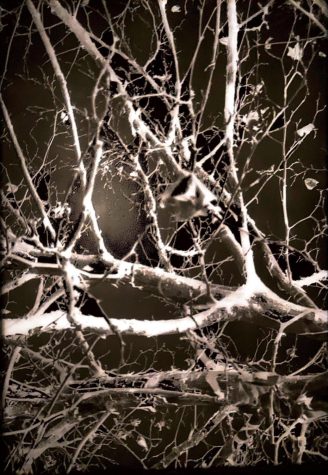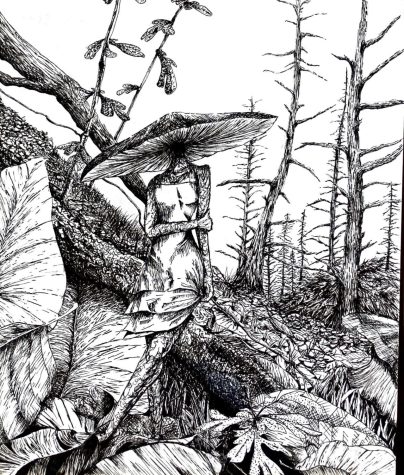Artists share excerpts from their portfolios
Students delve into photography, painting and drawing
February 4, 2022
Using different mediums, artists at MVHS express their emotions, beliefs, and interests through their artwork. Along with displaying their pieces, three students share the motives behind the techniques they use to fuel their artistry.

Junior Karan Goel
As he captures a photograph from underneath a tree that he calls “Remembrance,” junior Karan Goel is brought back to his childhood. Goel’s picture resurfaces his memories of the habits he had when he was younger, and he is reminded of the accomplishments he has made so far.
“I do think that [the photo] invokes for me the feeling of being a kid and thinking about all my dreams, how I would sit and just look at the sky,” Goel said. “I am the most proud of the way it came out in [the] post. When developing it can be hard to show contrast, perfect blacks and perfect whites, in my photo you could really tell that it’s not blurry.”
Goel says the “clearness” in his photo comes from the half hour process he went through developing the film because it is challenging to retain contrast in the image. To develop his pictures, Goel places the film in a changing bag, places it into a can, agitates the can with chemicals, and then dries the film. A skill he had to use was finding the correct F-stop, the part of a camera that changes the aperture, to use while taking his shots.
“Based on how light it is outside, I change the F-stop so that a different amount of light gets captured,” Goel said. “And that burns into the film in a different way.”

Senior Ivy Wang
With her belief of the importance of nature preservation as a focus, senior Ivy Wang’s oil painting “Fading Vision” is an intersection between Chinese culture and environmentalism. The woman’s dress is reminiscent of other artwork from ancient China. According to Wang, several symbols allude to nature, such as the fish jumping out of the waves and the dress also serves to depict mountains at the bottom of the painting. Her stylistic decision to use primary colors also highlights a message of environmental conservation that is central to her painting.
“There’s a threat when humans move more into the modern century and keep expanding cities, as shown in the crystal ball,” Wang said. “If humans are still not paying attention to environmental damage, the beauty of nature will fade away. In my painting, yellow and yellowish colors represent nature and in it the nature is in broken pieces.”
From a technical aspect, Wang explains that the blending and mixing of oil paints were important in areas of the piece such as the background and the dress. Additionally, to create a shining effect to parts of her painting, she had to make some additions.
“The crystal ball is a shiny object, so I had to add bits of highlights,” Wang said. “Also on the steel and the waves, I added highlights to make the painting seem more lively.”

Senior Cecelia Carbone
While going through her old sketchbooks, senior Cecelia Carbone found it interesting to try redoing an older piece after acquiring additional skills. After using a light pencil to create a base sketch and “lock in” aspects of her piece “Open,” Carbone transitioned to using felt tip pens. However, she had trouble finding a pen small enough to fill in smaller details.
“What I did was I took a dip pen, like the old timey ones with the ink, and it sounds counterintuitive to do that, but it gives you more control over the size,” Carbone said. “So I was able to do some really tiny details.”
Her primary focus for the piece was to have it be completed. According to her, this is reflected in the artwork as the bottom of the piece contains more details than the top, hence the name “Open.” For Carbone, the part she’s the proudest of are the trees.
“[The trees are] what I did with the zip pen, so they’re super detailed,” Carbone said. “It’s really fun to do them because they work so perfectly with how I arrange everything.”
















